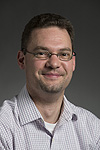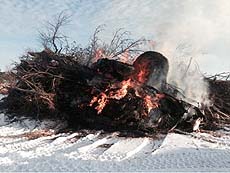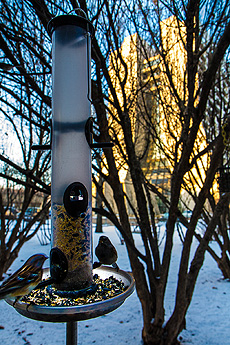|
Monday, Jan. 13
- Breakfast: oatmeal raisin pancakes
- Breakfast: sausage, egg and cheese croissant
- Fermi burger
- Roasted pork loin with orange mustard glaze
- Marinated roasted chicken
- Classic club sandwich
- Mandarin-orange pecan chicken salad
- Chicken and sausage gumbo
- Texas-style chili
- Assorted pizza by the slice
Wilson Hall Cafe menu
|
|
Wednesday, Jan. 15
Lunch
- Fish tacos with lime crema
- Pinto salad
- Coconut flan
Friday, Jan. 17
Dinner
- Zucchini fritters with yogurt dill sauce
- Filet mignon with cabernet sauce
- Peppery baked onions with sage and gruyere
- Smashed potatoes
- Espresso crème brûlée
Chez Leon menu
Call x3524 to make your reservation.
|
|
Oliver Gutsche earns CMS Young Researcher Prize
 |
|
Oliver Gutsche
|
Last month, the CMS collaboration awarded Oliver Gutsche, Scientific Computing Division, the CMS Young Researcher Prize at CERN for "his sustained and critical contributions to the development, deployment and operation of the worldwide distributed computing system of CMS."
The annual prize is intended to recognize outstanding achievements of the young members of CMS who have made a very significant and sustained contribution to CMS over many
years in any area, including hardware, software, analysis and technical areas. Gutsche was one of this year's five recipients.
Editor's note: The symmetry story below highlights some of the research that Gutsche and other LHC scientists work on.
 |
The medal for the Young Researcher Prize is a piece of the CMS solenoid, the largest solenoid in the world. In the middle picture, the superconducting wire, embedded in the aluminum, is visible. Photos courtesy of Oliver Gutsche, SCD
|
|
Physicists harness the power of probability
 |
What do the stock market, weather models and the discovery of the Higgs boson all have in common? They all are deeply indebted to statistics. |
Albert Einstein was greatly disturbed by the idea that the universe is governed by an intrinsic randomness. He deeply mistrusted quantum mechanics, the set of rules that describe how particles behave — seemingly haphazardly — at the tiniest scale. In a 1926 letter to fellow physicist Max Born about this, Einstein famously wrote in protest, "God doesn't play dice."
Quantum mechanics sabotaged Einstein's vision of elegant and deterministic natural laws. In 1935 he teamed up with two other scientists to disprove one of its principles — the Heisenberg uncertainty principle — which shows that it is impossible to know simultaneously the exact position and velocity of a particle.
But unfortunately for Einstein, his multiple attempts to gut quantum mechanics were in vain. Decades of physics research show that nature, at its most fundamental level, seems to be governed by chance.
Instead of battling this element of uncertainty, scientists — along with economists, meteorologists and casino owners — create statistical models to predict the behavior of particles, stocks, storms and clients at a blackjack table. They can't foresee exactly what will happen, but they can map the likelihood of different situations and develop a general idea of what they should expect. For example, a casino owner doesn't know exactly how much money a given patron will take away from the blackjack table. But, thanks to statistical modeling, he or she knows the average amount, and then uses this information to guarantee a steady profit.
Read more
—Sarah Charley
|
Java update effects on Fermilab Time and Labor
Oracle will release a Java update on Jan. 14. This may have a minor impact on the use of Fermilab Time and Labor (FTL). It may also affect other applications that use Java. The Core Computing Division expects the impact to be minimal but will not be able to test and confirm these potential impacts until the Java update is released on Jan. 14.
What you need to do
On or after Jan. 14, if you receive security warnings that you don't usually see when accessing FTL, please refer to this knowledge base article for examples of what the security warnings will look like and what to do with them. CCD intends to provide automatic software updates as soon as they become available to prevent these security warnings from appearing.
To avoid this potential impact, you can use the HTML version of the FTL site.
If you would like to read about the Java security updates, see this knowledge base article.
If you have any questions about the pop-ups, the Java update or FTL, please contact the service desk.
|
UC's Sousa to leverage OSC to simulate neutrino behavior
From the Ohio Supercomputer Center, Jan. 10, 2014
Columbus, Ohio —
A researcher at the University of Cincinnati is leveraging the computer and storage resources of the Ohio Supercomputer Center (OSC) to simulate the behavior of elusive cosmic particles in an experiment that may provide answers to the most fundamental questions in our understanding of the evolution of the universe.
Read more
|
|
Burning-wood ecology
 |
| Brush cleared from the area near the intersection of West Wilson and B roads burns in a recent brush fire. The large round object near the center of the pile is a bale of switchgrass from the bioenergy plots southwest of the Village. The waste bale was used to ignite the fire as an environmentally preferable alternative to a chemical fire starter. Photo: Dave Shemanske, FESS |
Part of the job of caring for the Fermilab site is occasionally removing unwanted vegetation. An integral part of the task of restoring large land areas to a productive and diverse state is removing unwanted woody vegetation, such as European buckthorn and dead and potentially unsafe trees, like the hundreds of trees killed by the emerald ash borer over the last 10 years. Dead trees in unpopulated areas of the site are normally left to provide habitats for birds, mammals, insects and other invertebrates.
Restoration of woodlands choked by weedy, non-native species often requires lots of clearing before restoration can be effected. Parts of the Director's Woods, the groves near Wilson and B roads and B and Receiving roads, and the Main Ring Savanna have undergone extensive clearing, which opens up the understory for the introduction of more desirable native plants. Some of the resulting biomass can be turned into mulch, but much of the scrubby material is disposed of by burning. Open burning raises questions about the ecological and environmental aspects of the practice.
Chief among the environmental concerns is the release of pollutants, specifically particulate matter that can act as a respiratory irritant. Thus burning brush as a part of our overall restoration effort requires a permit from the Illinois EPA, just like the more familiar prescribed prairie burns. The permit has conditions for burning that are intended to minimize the health impacts.
People are often concerned about the release of extra carbon in the form of CO2. It's true that burning wood, like burning anything organic, releases CO2. However, on a geologic scale, the carbon released from even the oldest trees was only temporarily stored in the plant tissue and will likely cycle back and forth from plant and animal tissue to the atmosphere many times over a number of years.
Open burning of brush piles, such as prescribed burns of prairie or woodlands, has many benefits to the laboratory and to ecology. Like most every stewardship practice, it has some disadvantages as well, pointing (once again!) to the need to consider carefully all aspects of the actions we decide to take when managing our environment.
—Rod Walton
|
Tuppence a tube
 |
| Two birds help themselves to some seeds at a bird feeder in the woods near Wilson Hall. Maurice Ball, AD, keeps the feeder stocked. Elliott McCrory, AD, captured the moment using a remotely controlled wireless shutter release. Photo: Elliott McCrory, AD |
|
|